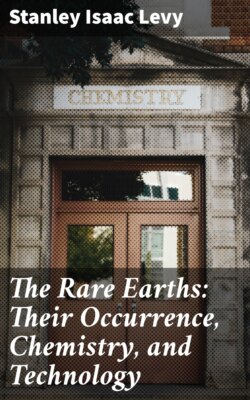Читать книгу The Rare Earths: Their Occurrence, Chemistry, and Technology - Stanley Isaac Levy - Страница 177
На сайте Литреса книга снята с продажи.
(a) Tantalo-Columbates containing no Titanium Dioxide Samarskite, Yttro-ilmenite or Eytlandite (Urano-tantalite).
Оглавление—Samarskite is a tantalo-columbate[59] of the rare earth metals, with iron, calcium, and uranium.
[59] In this and all similar minerals, columbium (niobium) and tantalum are to be regarded as vicarious; they replace each other in all proportions. It seldom happens that a pure columbate is found free from tantalum, or vice versa; one or other may predominate, but the two are almost always found together.
Rammelsberg gives the formula R´´₃R´´´₂(Cb,Ta)₆O₂₁, where R´´ = (Fe´´,Ca,UO₂), and R´´´ = rare earth metals. Groth regards it as essentially a pyrocolumbate (tantalate) of rare earth metals R₄[(Cb,Ta)₂O₇]₃ the iron, calcium and uranium being more or less accessory constituents. Des Cloizeaux considers the formula indefinite. The mineral has also been found to contain tin, thorium, germanium, and helium. The yttria earths usually predominate (11·9 to 18·9 per cent.), the percentage of ceria earths being low (2·4 to 5·2 per cent.). The yttria earths contain the very rare oxide samaria.
The mineral is radio-active.
Crystal system—orthorhombic; a: b: c = 0·5456: 1: 0·5178.
Forms—macro- and brachy-pinakoids a {100} and b {010}; prisms m {110} and h {120}, the macrodome e {101}, and pyramids p {111} and v {231}.
Angles—(100) ∧ (110) = 28° 37´; (001) ∧ (101) = 43° 30´; (001) ∧ (011) = 27° 221⁄2´.
Habit usually prismatic, with e prominent; sometimes tabular parallel to a or b. Cleavage ∥ b, imperfect. The faces are usually rough. The mineral commonly occurs massive, and in flattened grains embedded in granite. Conchoidal fracture. Brittle. Hardness 5 to 6; sp. gr. 5·6 to 5·8.
Colour velvet-black, streak reddish-brown. Opaque even in thin films.
Before the blowpipe it fuses at the edges; with borax it gives an iron bead. It is decomposed by boiling concentrated sulphuric acid, better by fusion with potassium hydrogen sulphate, and leaching the residue with dilute hydrochloric acid—this leaves the insoluble oxides Cb₂O₅ and Ta₂O₅. On heating it glows, with decrease in specific gravity (cf. p. 38).
Samarskite occurs with other columbo-tantalates in felspar, or in veins in granite, near Miask in the Urals, near Quebec in Canada, and in Mitchell County, North Carolina. From the last-named locality, masses up to twenty pounds in weight have been obtained.
The mineral was first discovered in the Urals by Ewreinoff, captain of a corps of Russian mountain engineers. He sent a specimen for identification to the mineralogist Gustave Rose, who pronounced it to be a tantalate of uranium containing manganese, and called it Urano-tantalite.[60] In 1847 the chemist Heinrich Rose, brother of Gustave, in the course of his researches on tantalic ‘acid’ (oxide), analysed a specimen. He found the composition given above, and renamed it Samarskite,[61] in honour of the Russian engineer who furnished him with the specimen for analysis.
